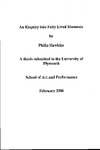An Enquiry into Fully Lived Moments
| dc.contributor.author | Hawkins, Philip | |
| dc.contributor.other | Faculty of Arts, Humanities and Business | en_US |
| dc.date.accessioned | 2013-11-07T11:16:36Z | |
| dc.date.available | 2013-11-07T11:16:36Z | |
| dc.date.issued | 2006 | |
| dc.identifier | NOT AVAILABLE | en_US |
| dc.identifier.uri | http://hdl.handle.net/10026.1/2651 | |
| dc.description | Merged with duplicate record 10026.1/1295 on 15.02.2017 by CS (TIS) | |
| dc.description.abstract |
The thesis explores facets of human agency and fully lived moments in the Cobra group, the ideas of Henri Lefebvre, and the ideas of Victor Burgin and psychoanalysis. Connective elements, and their relevance or not, through different disciplines, are a central part of its thinking. To this end some connections are found, some speculative connections are tracked, and there are some ideas that don't connect, yet come close to doing so but which become valuable for the examination of productive tensions and excesses about the lived in a cross-disciplinary enquiry. To begin with, an original set of historical and thematic alliances is established, that includes Cobra artists and thinkers, and their links, among others, to the Surrealists, Gaston Bachelard, and Henri Lefebvre, who were contemporaries. It includes the relevance of a plurality of productive and collaborative tensions in Cobra practices that de-stabilise a traditional aesthetic reading. In the next chapter, an original reading of Lefebvre's radical romantic ideas, as well as his contacts with art groups, are examined. This includes the Dadaists, Surrealists, ex-Cobra member Constant, and the early Situationists. In combination and in unresolved ways, the Cobra Group's collaborative aesthetic and Henri Lefebvre's radical romanticism encompass particular facets of a realm of human agency and fully lived moments. In its enquiry for a more contemporary context in art theory the thesis finds scope for a cautious re-consideration of fully lived moments and lived time and for stretching its methodological complexity. Given the propensity of historical material theories to marginalise reflexive insights, and given an existing realm of Victor Burgin's ideas about Lefebvre, art theory, and psychoanalysis, his ideas are investigated and differentiated critically. This helps to highlight the importance of misalignments and problems of equivalence with ideas about fully lived moments. The chapter also highlights differences between: Burgin and Lefebvre; between Burgin's synthetic psychoanalytic realm and other psychoanalytic approaches; and it highlights the limited relevance of Lefebvre's notions of alterity. Other sets of near connections and potential fractures in human agency and dimensional aspects of the lived are explored in object relations and Freudian theory. This is not an art historical commentary about Cobra art. Its history focuses on a set of productive tensions that destabilise art historical and traditional aesthetic categorisations. However, Cobra practice is not reduced into an outside aesthetic realm, or a thinking vivacity either. Similarly, the thesis magnifies only a portion of Lefebvre's thinking. It presents an original interpretation of Lefebvre's work by putting together a range of ideas, connections and texts about his radical romanticism that highlight the lived or contexts outside of a traditional aesthetic. Similarly in the radical romantic strains of Lefebvre's work unresolveability highlights a particular set of creative and sociological connections, but also problems. This includes for example the relative strengths of bringing together poiesis (creativity) and praxis (social practice) that Lefebvre, to a certain extent, attempts to resolve as an aspect of social practice. Unresolveability explores its field in aesthetic, visual cultural or radical romantic terms, despite connections - in the everyday and cultural theory for example - as up against the impossible in terms of being resolved into an aesthetic synthesis or dimension. At its broadest, and for the second term, non-resolveability relates to the intrinsic limitations of equivalence across disciplines in the thesis. Paradoxically the thesis attempts to realise a field of the fully lived moment in thought and action, while also highlighting specific limits and nonresolveable problems of its reach. A cross-disciplinary approach examines the value of bringing together methodologies and specific fields from different directions. It examines productive configurations across disciplinary vectors of thought. Furthermore however its reach highlights notions of contradiction in the lived. It highlights notions of excess that cut across Lefebvre's radical romanticism, Cobra's aesthetic, and Burgin's psychical realms. The thesis attempts, and complicates, a theory of fully lived moments. For example, in Lefebvre's sociological perspectives and in the psychoanalytic, different registers of thought, value, and agency are highlighted. Given disparate registers, non-resolveability struggles against developing one methodology or field at the expense of others. This becomes a means, in exploratory ways, for tracking connections from disparate mapping processes. Furthermore, scope for the potential reinterpretation of specific concepts and contexts, for discursive and creative thinking across registers, are introduced. The thesis concludes that there is scope for alliances in unresolveable thematic connections between Cobra Art and Lefebvre where an interesting transitional field about the lived is found. It presents the importance and originality of a field of concepts, values and ideas about fully lived moments. Yet it also introduces some of the disparate and nonresolveable scope of its fractures in reflexive or art theoretical realms. | en_US |
| dc.language.iso | en | en_US |
| dc.publisher | University of Plymouth | en_US |
| dc.title | An Enquiry into Fully Lived Moments | en_US |
| dc.type | Thesis | |
| plymouth.version | Full version | en_US |
| dc.identifier.doi | http://dx.doi.org/10.24382/4429 |
Files in this item
This item appears in the following Collection(s)
-
01 Research Theses Main Collection
Research Theses Main


